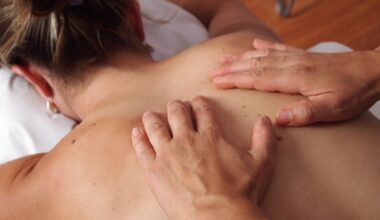Chair Exercises for Seniors with Limited Mobility
Chair exercises are a fantastic way for seniors experiencing limited mobility to engage in regular physical activity safely and comfortably. These exercises can help improve strength, flexibility, and balance while allowing participants to remain seated. This is especially crucial for seniors who might find traditional exercises challenging or excessively strenuous. The benefits of chair exercises go beyond physical fitness; they can also help enhance mental well-being, boost mood, and promote social interaction if done in groups. People who participate regularly can experience improvements in their overall quality of life, as exercise helps maintain independence and functionality. Additionally, these exercises are often low-impact, making them suitable for various conditions including arthritis and other joint issues. Incorporating a few simple chair exercises into daily routines can truly transform a senior’s lifestyle. It requires minimal equipment – typically just a sturdy chair and possibly some light weights – which makes accessing these activities easy. Thus, chair exercises can be adapted to accommodate different fitness levels, making them an excellent option for almost everyone. With consistency, seniors can acquire and enjoy the multiple advantages of exercising without the burden of intense physical demands.
One of the simplest yet effective chair exercises is the seated leg lift. To perform this exercise, sit comfortably in a chair with feet flat on the ground. Slowly extend one leg outwards in front of you, keeping the knee straight. Hold this position for a few seconds before returning the leg to the starting position. Repeat this movement several times for each leg. This exercise can improve leg strength and flexibility, which are essential for maintaining mobility. Another excellent chair exercise is the arm raise, which helps strengthen the arms and shoulders. To execute this, sit upright in your chair and slowly raise both arms above your head while inhaling deeply. Then, exhale as you lower them back down. Aim for repetitions based on your comfort level. Remember, each movement should be done slowly to avoid strain. Consistent practice of these exercises can also enhance blood circulation. Additionally, performing stretching exercises while seated can improve flexibility. Try gently reaching towards your toes while seated. Maintain each stretch for 10 to 30 seconds and remember to breathe deeply. These simple exercises can build confidence and safely improve everyday functionality.
Chair exercises also include seated marches, which mimic a traditional marching motion while seated. For seniors, this exercise aids in increasing cardiovascular endurance while improving coordination. To perform this, elevate your knees alternately as if walking in place. Do this for a set period, ideally one to five minutes, adjusting based on individual comfort. It’s essential to maintain a steady rhythm. As you become comfortable, consider combining arm movements, such as swinging them in a marching motion, to work the upper body simultaneously. Another beneficial exercise is the seated torso twist. This movement promotes flexibility in the back and core muscles. To start, sit upright in a chair with feet flat on the ground, then gently twist your torso to one side, holding the position for several seconds before returning to center. Repeat this to the other side. Each repetition can gradually stimulate the spine’s mobility. These movements can be particularly advantageous for seniors experiencing stiffness or back discomfort. Always ensure you maintain a good posture during these dynamics. Integrating these unique and essential exercises into daily routines can significantly enhance the overall health and lifestyle for seniors with limited mobility.
Flexibility and Balance
Stretching is vital for maintaining flexibility. Incorporating chair stretches into your routine can be very effective in promoting overall mobility. An example is the seated shoulder stretch. Begin by sitting at the edge of your chair, bringing one arm across your body, and gently pulling it closer with the opposite hand. Hold the stretch for around 15 to 30 seconds before switching sides. This exercise helps relieve tension in the shoulders and upper back, especially beneficial for those who spend long periods sitting. Furthermore, seated calf raises can contribute to strengthening the muscles in the lower legs, promoting better balance. To execute this, keep your feet flat on the ground while lifting your heels and returning to the start. These and other stretches can enhance synthesis between strength and flexibility, thus helping prevent falls, which are crucial for seniors. Developing a stronger balance and flexibility foundation helps maintain independence in everyday activities. Practicing these stretches several times a week can yield surprising improvements in overall mobility. These exercises engage the core subtly, which is often neglected, yet vital for stability.
Another valuable chair exercise is the seated side leg lift, ideal for strengthening hip muscles. From a sitting position, extend one leg out to the side without leaning over. Hold it there for a few seconds before lowering it back down. This exercise can help prevent falls by enhancing stability at the hips. Repeating this on both sides increases the effectiveness. Maintaining strong hip muscles also facilitates movements such as standing and walking. Additionally, integrating breathing exercises while performing chair workouts can significantly elevate an overall feeling of well-being. Deep and controlled breathing calms the body and can help maximize the benefits of movements. To take a breath break between exercises, simply inhale deeply, filling your lungs, and let it out slowly. It allows seniors to relax and refocus their energy. Visualizing one’s improvement can provide motivation, making every session feel less like a chore and more of an accomplishment. Utilizing various modifications and personalizing exercises to fit ability levels fosters inclusivity and accommodates differences in mobility levels. By valuing each small achievement in physical progress, seniors can experience a renewed sense of empowerment through fitness.
Creating a Routine
Establishing a routine for chair exercises is crucial, particularly for seniors. Consistency is key for improvement. Start by scheduling specific times during the week for exercise, ensuring a comfortable and quiet space without distractions. Aim for at least three sessions each week to build a habit, gradually increasing duration and intensity as strength and stamina improve over time. Remember to mix exercises to cover various muscle groups. Engage in warm-up movements before starting and cool down afterwards to prevent injury and promote recovery. Engaging family members or friends can motivate participation and foster social connection. Sometimes, creating a friendly competition can encourage engagement and commitment. Consider using music that enhances rhythm and enjoyment throughout sessions. This can elevate mood while also promoting an energetic atmosphere. Tracking progress is another essential factor; journaling or using an app to note improvements can reinforce consistency. Celebrate milestones, regardless of how small they may seem, as every effort counts. Make adjustments according to how the body responds. It is essential to listen to one’s body to avoid strain, ensuring that chair exercises are enjoyable rather than a source of stress.
Chair exercises don’t just enhance physical health; they also foster mental well-being. Engaging in activities that promote movement can release endorphins, the body’s natural mood lifters, heightening happiness and reducing anxiety levels. Cognitive engagement through movement can also stimulate memory and mental clarity. Incorporating familiar songs or discussions around memories can boost enjoyment during exercise sessions. Those with limited mobility may often feel isolated; chair exercises offer an excellent opportunity for socialization. Group classes or exercising with family creates accountability and support networks. Consider online classes or resources that provide guidance; many platforms offer accessible chair exercise videos tailored for seniors. These resources can accommodate various fitness levels and preferences. Many local community centers or health organizations provide programs designed specifically for seniors, also emphasizing social aspects. Always consult with a healthcare professional or fitness expert when beginning any new exercise routine, particularly for those with existing health conditions. Personalizing routines ensures safety while maximizing benefits. Regular participation, even in small quantities, helps cultivate a positive routine that fosters both physical and emotional well-being, enhancing overall quality of life for seniors engaged in chair exercises.
Lastly, ensuring accessibility to modifications is vital as not every exercise suits everyone equally. Some seniors may require additional aids, like resistance bands or light weights, to enhance their routines. Incorporating these tools can intensify workouts and build strength more effectively. It’s equally important to foster a supportive environment that encourages experimentation with exercises. Afford participants the freedom to adapt movements according to comfort levels. Seeking guidance from certified instructors, especially those specializing in senior fitness, can lead to safer, more effective routines. They can provide individual assessments and modifications to tailor exercises to participants’ specific needs and restrictions. Engaging in regular feedback about the difficulties experienced during exercise can foster trust and community while understanding personal limits. Solutions like chair exercises prove that physical activity does not have to be high-impact to be beneficial, as older adults can continue enjoying movement exercises safely. Encouraging exploration of different chair exercises complements various physical abilities and strengthens morale. All of these aspects contribute to an empowering atmosphere promoting physical activity among seniors with limited mobility. By focusing on achievable goals, seniors can find joy in maintaining their fitness journey while adapting at their own pace.


